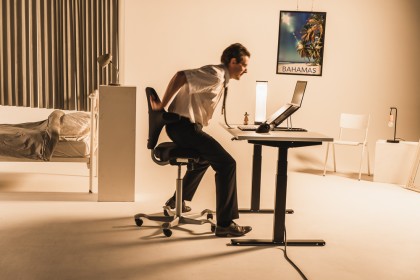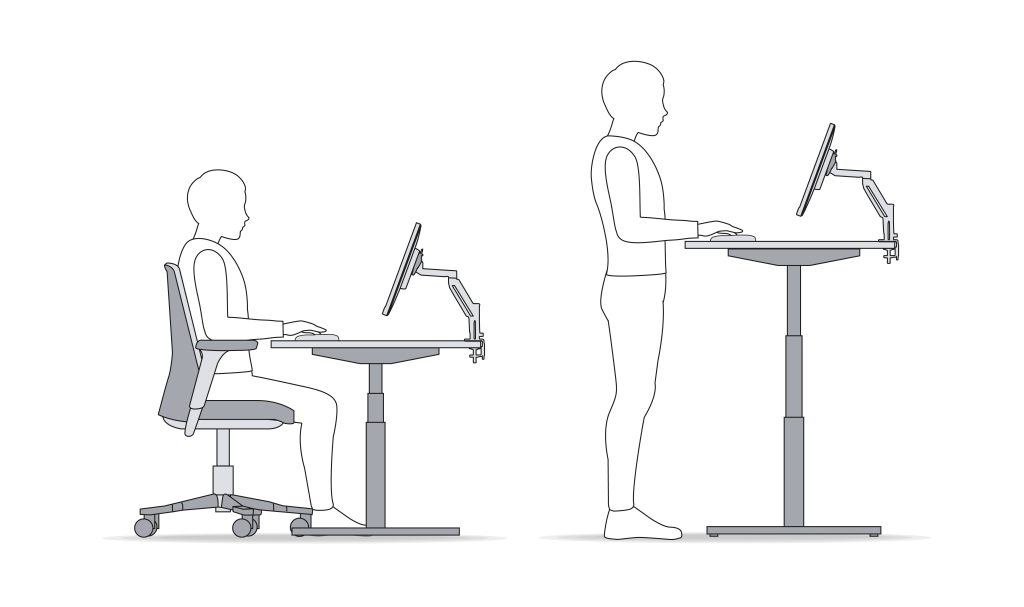Our solutions
Back
Physical movement
The dangers of sitting for long periods, day in and day out, are obvious. The benefits of changing attitudes, including improved focus, engagement and well-being, are also apparent. Standing at work provides a break from sitting, helps offset some of the problems that can arise from prolonged sitting, and keeps employees moving. Given Hamilton's findings, these benefits alone are an incentive for employees to spend part of the workday standing, whether meeting in a common room or working in height-adjustable workstations.
Based on research
For centuries, researchers knew there was a link between sedentary staff and health problems. In 1700, for example, an Italian physician, Bernardino Ramazini, noted that tailors who sat at work were not as healthy as deliverymen who walked while they worked (Ramazzini, 1713). Generations later, a British study (Morris & Crawford, 1958) showed that cardiovascular disease was less frequent and less severe among bus conductors and postmen than among bus drivers and telephone operators, who were more likely to do sedentary work.
Recent Hamilton studies focus more on how biological systems function, measuring the regulation of blood glucose levels and metabolic differences in animals and humans engaged in sedentary behavior (duration of physical inactivity) compared to those experiencing common levels of activity during waking hours. . The results added new weight to what has become widely known since the days of Ramazini: that inactivity in the office and at home can have a significant negative effect on human physiology.
The study results support the idea that movement throughout the day, while sitting, walking or standing, is critical to maintaining your well-being (everything from less repetitive movement injuries to reduced weight gain), promoting concentration, focus and increasing productivity (DeRango et al., 2003).
Experts such as Donald D. Harrison (Harrison et al., 1999) know that there is no one best posture. Instead, changing attitudes is the key to success.
Recent Hamilton studies focus more on how biological systems function, measuring the regulation of blood glucose levels and metabolic differences in animals and humans engaged in sedentary behavior (duration of physical inactivity) compared to those experiencing common levels of activity during waking hours. . The results added new weight to what has become widely known since the days of Ramazini: that inactivity in the office and at home can have a significant negative effect on human physiology.
The study results support the idea that movement throughout the day, while sitting, walking or standing, is critical to maintaining your well-being (everything from less repetitive movement injuries to reduced weight gain), promoting concentration, focus and increasing productivity (DeRango et al., 2003).
Experts such as Donald D. Harrison (Harrison et al., 1999) know that there is no one best posture. Instead, changing attitudes is the key to success.
BakkerElkhuizen believes that influencing workplace and work behavior can help keep employees moving. This will help improve performance and well-being. Since sedentary behavior is an independent risk factor for increased rates of illness (Katzmarzyk et al., 2009), more exercise may result in less loss of an organization's total workforce due to absenteeism. More importantly, physical exercise can help employees be more focused and productive throughout the workday.
Work Smart, Feel Good. This is a specific philosophy that BakkerElkhuizen uses to enable employees to perform optimally. Workplaces that embrace this philosophy offer possibilities for height-adjustable desks, active sitting, motivation to move and focused work.
Work Smart, Feel Good. This is a specific philosophy that BakkerElkhuizen uses to enable employees to perform optimally. Workplaces that embrace this philosophy offer possibilities for height-adjustable desks, active sitting, motivation to move and focused work.
1.1. Standing while work
The dangers of sitting for long periods, day in and day out, are obvious. The benefits of changing postures, including improved focus, concentration and well-being, are also apparent. Standing at work provides a break from sitting, helps offset some of the problems that can arise from prolonged sitting, and keeps employees moving. Given Hamilton's findings, these benefits alone are an incentive for employees to spend part of the workday standing, whether meeting in a common room or working in height-adjustable workstations.
Standing for just one hour a day can help employees burn extra calories and maintain or renew their energy levels and focus. And desks that can be easily adjusted from seated to standing positions eliminate the need for employees to leave their jobs when they need a break from their seated position, keeping them more productive throughout the day.
When switching between sitting and standing work, it is important to check the viewing distances to the screen. The height of the screen in relation to the table is different for sitting work than for standing work. This has to do with the extension and bending of the trunk, the lower you sit the more you are in a flex pattern. That is why the elbow height is often chosen a bit lower by the user when working standing up.
It is therefore important to facilitate flexible adjustable screens for employees. This can be done by means of adjustable laptop stands, monitor stands or adjustable monitor arms.
Standing for just one hour a day can help employees burn extra calories and maintain or renew their energy levels and focus. And desks that can be easily adjusted from seated to standing positions eliminate the need for employees to leave their jobs when they need a break from their seated position, keeping them more productive throughout the day.
When switching between sitting and standing work, it is important to check the viewing distances to the screen. The height of the screen in relation to the table is different for sitting work than for standing work. This has to do with the extension and bending of the trunk, the lower you sit the more you are in a flex pattern. That is why the elbow height is often chosen a bit lower by the user when working standing up.
It is therefore important to facilitate flexible adjustable screens for employees. This can be done by means of adjustable laptop stands, monitor stands or adjustable monitor arms.
1.2. Movement during work
Modern medicine continues to confirm Ramazini's study of delivery men and tailors. Movement is healthy. BakkerElkhuizen has embraced this and has innovative solutions to offer movement through coaching in combination with hardware such as height-adjustable sit-stand desks and active-sitting solutions. When used for standing tasks, it allows the worker to keep moving - boosting productivity.
Providing a way to keep moving and thus stay on the job can keep an employee's metabolism moving and have a positive impact on overall health.
The combination of coaching and the possibility to exercise is essential. For example, research (Garret, et al., 2019) shows that the use of sit-stand desks increases by 229% when this is combined with nudging, or coaching, which encourages switching position between sitting and standing. The effects of movement, and the alternation between sitting and standing, are thus further reinforced on top of the employee's own motivation to do so.
Providing a way to keep moving and thus stay on the job can keep an employee's metabolism moving and have a positive impact on overall health.
The combination of coaching and the possibility to exercise is essential. For example, research (Garret, et al., 2019) shows that the use of sit-stand desks increases by 229% when this is combined with nudging, or coaching, which encourages switching position between sitting and standing. The effects of movement, and the alternation between sitting and standing, are thus further reinforced on top of the employee's own motivation to do so.
1.3. Training
Offering good sit/stand options sounds like a great way to keep everyone happy. One of the challenges in offering employees choices is that they can make the wrong ones. By giving too much leeway, too much agency, employers may be returning to the predicament they started in: employees not being encouraged to exercise.
Effective education and training in employee work behavior is critical not only in chair selection, but also in the effective use of chair functions, as well as in the use of height-adjustable desks. All too often, companies invest in products that should improve employee wellbeing and engagement, but often fail to do so because they use chairs, desks and other hardware ineffectively, incorrectly, or erratically.
Training and education are made even more important by the realities of today's workplace. Employees are mobile. Armed with smartphones and laptops, they can, and do, work anywhere. But while the benefits of this kind of mobile movement are obvious, so are the risks. Not every mobile workplace automatically offers access to a healthy working posture and/or tools to stimulate mental and physical movement. However, there are also many mobile and/or hybrid solutions available to guarantee movement and a healthy working posture in any type of workplace. Whether you work fixed, mobile or hybrid.
Employers must be willing to educate employees about the choices available and how to make the right ones. Employees also have a responsibility. The good news is that the right tools are in place, but the bad news is that they are still subject to employee use. Employees need to become more aware of the options available and, as they move throughout the day, learn how to choose their postures and workplace layout wisely.
Effective education and training in employee work behavior is critical not only in chair selection, but also in the effective use of chair functions, as well as in the use of height-adjustable desks. All too often, companies invest in products that should improve employee wellbeing and engagement, but often fail to do so because they use chairs, desks and other hardware ineffectively, incorrectly, or erratically.
Training and education are made even more important by the realities of today's workplace. Employees are mobile. Armed with smartphones and laptops, they can, and do, work anywhere. But while the benefits of this kind of mobile movement are obvious, so are the risks. Not every mobile workplace automatically offers access to a healthy working posture and/or tools to stimulate mental and physical movement. However, there are also many mobile and/or hybrid solutions available to guarantee movement and a healthy working posture in any type of workplace. Whether you work fixed, mobile or hybrid.
Employers must be willing to educate employees about the choices available and how to make the right ones. Employees also have a responsibility. The good news is that the right tools are in place, but the bad news is that they are still subject to employee use. Employees need to become more aware of the options available and, as they move throughout the day, learn how to choose their postures and workplace layout wisely.
1.4. The benefits of physical exercise: active, alert and focused employees
There are clear, tangible benefits to providing employees with the means to move between postures and workspaces throughout the day:
- High-quality, task-specific sit/stand options reduce employee fatigue and absenteeism due to repetitive movements.
- Less absenteeism and fatigue means more time at work, better daily work performance and lower absenteeism costs.
- Allowing employees to alternate between sitting, standing and moving during work eliminates the need to leave work, keeps them focused and increases productivity.

Why you should apply the Work Smart, Feel Good
When companies adopt a Work Smart, Feel Good strategy, they are also addressing a fundamental problem that all employers face. Employees of today are heavier and less healthy than the employees of the past. That's because they don't just sit for long periods in the office; this is just as true in the home workplace. By offering sitting, standing, and moving options and the training to use them appropriately, employers can foster a new level of employee responsibility in any workplace throughout the workday.
A Work Smart, Feel Good strategy also offers intangible benefits. By contributing to a higher level of well-being, you can feel more positive about the work environment. It can help your company's image, making it more attractive to potential colleagues. As a result, you not only feel better; but you and your colleagues are also more involved in the work. Ultimately, this generally leads to a stronger organization.
A Work Smart, Feel Good strategy also offers intangible benefits. By contributing to a higher level of well-being, you can feel more positive about the work environment. It can help your company's image, making it more attractive to potential colleagues. As a result, you not only feel better; but you and your colleagues are also more involved in the work. Ultimately, this generally leads to a stronger organization.
Need help? We're here for you
Look at our FAQ or contact us
Many customers preceded you
Read about their experience with BakkerElkhuizen
Select your country and language





